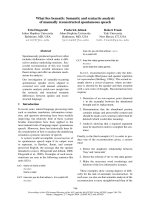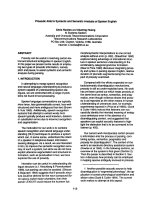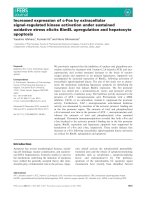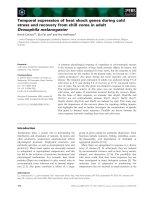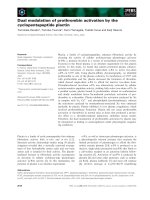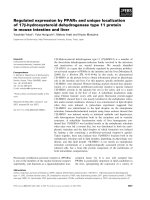Báo cáo khoa học: Dual expression of mouse and rat VRL-1 in the dorsal root ganglion derived cell line F-11 and biochemical analysis of VRL-1 after heterologous expression pptx
Bạn đang xem bản rút gọn của tài liệu. Xem và tải ngay bản đầy đủ của tài liệu tại đây (522.09 KB, 8 trang )
Dual expression of mouse and rat VRL-1 in the dorsal root ganglion
derived cell line F-11 and biochemical analysis of VRL-1
after heterologous expression
Ricarda Jahnel
1,
*, Olaf Bender
1,
*, Lisa M. Mu¨ nter
1
, Mathias Dreger
1
, Clemens Gillen
2
and Ferdinand Hucho
1
1
Arbeitsgruppe Neurochemie, Institut fu
¨
r Chemie-Biochemie, Freie Universita
¨
t Berlin, Germany;
2
Gru
¨
nenthal GmbH,
Aachen, Germany
The vanilloid-like TRP-channel VRL-1 (TRPV2) is a non-
selective cation channel expressed by primary sensory
neurons and non-neuronal tissues [Caterina, M.J., Rosen,
T.A., Tominaga, M., Brake, A.J and Julius, D. (1999)
Nature 398, 436–441]. It is one of the six members of the
vanilloid-like TRP-channel family which is now termed the
TRPV family [Montell, G., Birnbaumer, L., Flockerzi, V.,
Bindels, R.J., Brutford, E.A., Caterina, M.J., Clapham,
D.E., Harteneck, C., Heller, S., Julius, D., Kojima, I.,
Mori, Y., Penner, R., Prawitt, D., Scharenberg, A.M.,
Schultz, G., Shimizu, N. and Zhu, M.X. (2002) Mol. Cell
2, 229–231]. As it is a temperature-gated channel, VRL-1
appears to be functionally related to VR1. In contrast to
VR1, VRL-1 is activated at a higher temperature threshold
and it does not respond to capsaicin or protons. Here we
describe the expression of VRL-1 in the rat dorsal root
ganglion-derived cell line F-11, a hybridoma of mouse
neuroblastoma (N18TG2) and rat dorsal root ganglion
cells. We found by RT-PCR that F-11 cells express not
only the rat VRL-1, but also its mouse orthologue in a
single cell. The F-11 parental cell line N18TG2 also
expressed murine VRL-1. Due to its neuronal character,
the DRG-derived F-11 cell line provides an experimental
system for the study of VRL-1 biochemistry. However, one
has to be aware that both the mouse and the rat protein
are expressed simultaneously. Furthermore we cloned
VRL-1 from rat brain and analyzed its glycosylation and
localization in comparison to the endogenously expressed
protein in F-11 cells. In contrast to the endogenous VRL-1
the overexpressed protein is glycosylated. Similar to VR1
the glycosylation is N-linked as shown by an deglycosyla-
tion assay. Immunofluorescence analysis of the endo-
genous VRL-1 in F-11 cells gives only weak signals in the
cytoplasm whereas the overexpressed rat VRL-1 appears
mainly at the plasma membrane.
Keywords: TRPV2; F-11; glycosylation; localization; single
cell RT-PCR.
The vanilloid receptor 1 (VR1 or TRPV1) is a cation
channel predominantly expressed by primary sensory neu-
rons involved in nociception. Caterina et al.[1]isolateda
cDNA encoding the homologous VRL-1 by searching an
EST database for sequences related to VR1. According to
the new nomenclature, VRL-1 is now referred to as TRPV2
[2]. The rat cDNA (Acc. No. AF129113) encodes a 761-
amino acid VRL-1 protein, which is 82% identical to the
mouse protein of 756 amino acids (Acc. No. NM_011706),
and 78% identical to the human VRL-1 protein (Acc. No.
NM_016113) of 764 amino acids. Computer analysis of the
sequence predicts six transmembrane sequences, a pore-
loop, a cytoplasmic N-terminal sequence with three anky-
rin-repeat domains, and a cytoplasmic C-terminal sequence.
Functional analysis showed that VRL-1 does not respond
to capsaicin, low pH or moderate heat, but is activated at
high temperatures, with a threshold at about 52 °C [1].
Immunocytochemical experiments revealed that VRL-1 is
expressed in medium- to large-diameter dorsal root ganglion
neurons and in the spinal cord, specifically in Lissauer’s
tract and the dorsal horn [1]. Ichikawa et al.[3]detected
VRL-1 immunoreactivity in 14% of the trigeminal ganglia
cell bodies. Furthermore Stenholm et al. [4] found VRL-1 in
the tooth pulp-innervating neurons and the gingival
neurons. Co-expression with VR1 was rarely observed.
Northern blot analysis revealed expression of an approxi-
mately 2.5-kb VRL-1 transcript in rat sensory ganglia and
spinal cord, as well as in lung, spleen, intestine, and multiple
brain subregions [1]. This led to the speculation that non-
neuronal tissues expressing VRL-1 probably respond to
stimuli other than heat. An endogenous ligand for VRL-1
still has to be identified.
One property of the murine VRL-1 which Kanzaki et al.
[5] had originally identified as a Ca
2+
-permeable channel
(GRC) from mouse spleen is the regulation by insulin-like
growth factor (IGF-1). IGF-1 causes the translocation of
GRC to the plasma membrane where it forms a constitu-
tively active channel at room temperature. However, it still
Correspondence to F. Hucho, Institut fu
¨
r Chemie-Biochemie,
Freie Universita
¨
t Berlin, Thielallee 63, 14195 Berlin, Germany.
Fax: + 49 0308385 3753, Tel.: + 49 0308385 5545,
E-mail:
Abbreviations:DAPI,4¢-6-diamidino-2-phenylindole-2HCl; DRG,
dorsal root ganglion; GRC, growth-factor-regulated channel; TRP,
transient receptor potential; VR1, vanilloid receptor type 1 (TRPV1);
m/rVRL-1, mouse/rat vanilloid receptor-like protein 1 (TRPV2).
*Note: Both authors contributed equally to this work.
(Received 17 July 2003, revised 21 August 2003,
accepted 1 September 2003)
Eur. J. Biochem. 270, 4264–4271 (2003) Ó FEBS 2003 doi:10.1046/j.1432-1033.2003.03811.x
needs to be investigated how this relates to the rat and
human VRL-1.
We previously investigated biochemical characteristics of
the capsaicin sensitive Vanilloid receptor VR1 transiently
transfected in the rat dorsal root ganglia derived cell line
F-11, a hybridoma of mouse neuroblastoma and rat dorsal
root ganglion cells [6]. VR1 expressed in a neuronal cell
system should be more related to the in vivo situation than
fibroblast- or kidney-derived cell lines. VR1 was not
endogenously expressed in F-11 cells. These cells, formerly
generated and characterized by Platika et al. [7] and Francel
et al. [8], have been proven useful models for authentic
DRG cells. They showed that several features of differen-
tiated DRG cells are present in F-11 cells, e.g. release of
substance P, the presence of l-andd-opioid receptors,
receptors for prostaglandin and bradykinin and
L
-type
calcium channels. Recently, Bender et al. [9] isolated a rat
VRL-1 mRNA from F-11 cells identical to that observed in
dorsal root ganglia extracts. They suggested, that the F-11
cells most likely are derived from medium-sized Ad-fibers.
Here we show that the F-11 cells not only express the rat
VRL-1, but also the mouse VRL-1 and that the mouse
variant is derived from the F-11 parental cell line N18TG2.
This finding is of interest when VRL-1 is functionally
studied in these cells. Additionally in this study we cloned
VRL-1 from total RNA isolated from rat brain and
analyzed the glycosylation and localization of the endo-
genous VRL-1 in F-11 cells compared to VRL-1 over-
expressed in the same cell line.
Experimental procedures
Reverse transcription of rat brain, F-11 and N18TG2
total RNA
Total RNA of rat brain, F-11 and N18TG2 cells was
prepared using TRIzol Reagent (Invitrogen) according to
the instruction of the manufacturer. 1 lgtotalRNAwas
incubated for 10 min at 65 °C with 500 ng Oligo(dT)-
Primer and chilled on ice. First strand synthesis was
performed in a 20-lL reaction with 200 U Superscript II
reverse transcriptase in the presence of 40 U RNAse
Out, 500 l
M
each dNTP and 5 m
M
dithiothreitol (all
reagents from Invitrogen) at 42 °C for 60 min followed
by an inactivation step at 70 °Cfor15min.Asacontrol
each sample was additionally treated without reverse
transcriptase.
VRL-1 specific PCR
To portray rat VRL-1 in overlapping PCR fragments in
F-11 cells PCR primers were designed according to the rat
VRL-1 sequence (Acc. No. AF129113).
rVRL-1–34F: 5¢-CTGGAGACTTCCGATGGAGA-3¢
and rVRL-1–568R: 5¢-CATCCGCTCCATTCTCTACC-3¢
to obtain fragment A with 534 bp; rVRL-1–549F:
5¢-GGTAGAGAATGGAGCGGATG-3¢ and rVRL-1–
1205R: 5¢-ACCAAGTAGCAGGCGAAGTT-3¢ to obtain
fragment B with 656 bp; VRL-1/1061F: 5¢-ACTCGGTGC
TGGAGATCATC-3¢ and VRL-1/1897R: 5¢-TGAGAAG
GACGTAGGCCAAC-3¢ to obtain fragment C with
836 bp; rVRL-1–1618F: 5¢-TTCCTGCTGGTCTACCTG
GT-3¢ and rVRL-1–2251R: 5¢-CTTCCTCTGAGGCACT
GTTC-3¢ to obtain fragment D with 633 bp.
All primers were purchased from MWG Biotech AG.
PCR was performed with rat brain, N18TG2 and F-11
cDNA as template. Two microlitres RT reaction was used
in 25 lL PCR amplifications using Taq-DNA-Polymerase
(Invitrogen) after heating the sample to 95 °C for 3 min.
PCR conditions were 94 °C,30s;57°C,30s;72°C,30s
for 35 cycle and an additional elongation step at 72 °C for
7 min. PCR was analyzed by electrophoresis in a 0.9%
agarose gel.
Single cell RT-PCR of F-11 cells
F-11 cells were diluted in 5 · RT first strand buffer to a
concentration of 1 cell per 4 lL and checked under the
microscope in a 96-well plate. Only single cells were used for
directly reverse transcription and PCR. First strand synthe-
sis was performed in a 20-lL reaction with 200 U Super-
script II reverse transcriptase in the presence of 40 U
RNAse Out and 5 m
M
dithiothreitol (all reagents from
Invitrogen) at 42 °C for 60 min followed by an inactivation
step at 70 °C for 15 min. As a control each sample was
additionally treated without reverse transcriptase. PCR was
performed as described above for 40 instead of 35 cycles.
Non-denaturing PAGE
PCR products in a nondenaturing sample buffer were
loaded on a 6% nondenaturing PAGE (buffered by tris-
borate-EDTA). The gel was stained in an ethidiumbromide
bath for 20 min and visualized under UV light. Bands were
eluted by the crush and soak method [10] and DNA purified
by Phenol/Chloroform extraction. PCR fragments were
ligated into the pCRII-TOPO vector (Invitrogen) and
sequenced. The accuracy of sequences from the open
reading frame was checked by DNA sequencing of both
strands. The resulting sequences of specific bands were
identical to GenBank sequence Acc. No. AF129113 or Acc.
No. NM_011706.
Cloning of rVRL-1
Rat vanilloid receptor like-protein 1 (rVRL-1) was cloned
from total rat brain cDNA. Reverse-transcription poly-
merase chain reaction (RT-PCR) was carried out with
specific rVRL-1 forward and reverse primers designed using
the GenBank sequence AF129113. Primers corresponding
to nucleotides 330–353 and 2587–2610 (rVRL-1_F: 5¢-AT
GACTTCAGCCTCCAGCCCCCCA-3¢ and rVRL-1_R:
5¢-GGGACTGGAGGACCTGAAGGGGCA-3¢, respect-
ively) were used to clone the open reading frame of rVRL-1
in frame with GFP into the pcDNA3.1/CT-GFP-TOPO
vector (Invitrogen). A 2.5 lL RT reaction was used in
25 lL PCR amplifications containing 4% dimethylsulfox-
ide using Pfu Polymerase (Life Technologies). After heating
thesampleto95°C for 3 min PCR conditions were: 95 °C,
30 s; 57 °C,30s;72°C, 5 min for 35 cycles and an
additional elongation step at 72 °C for 7 min. To create
5¢A-overhang for TOPO cloning the reaction was incubated
with Taq-DNA-Polymerase (Promega) for 20 min at 72 °C.
PCR was analyzed by electrophoresis in a 1% agarose gel
Ó FEBS 2003 Co-expression of mouse and rat VRL-1 in F-11 cells (Eur. J. Biochem. 270) 4265
for the presence of specific 2.3 kb rVRL-1 band. The
band was excised from the gel and purified with UltraClean
DNA Purification Kit (MOBIO Laboratories, Inc.) using
the manufacturer’s instructions. Four microlitres rVRL-1
cDNA was ligated into 1 lL pcDNA3.1/CT-GFP-TOPO
vector in the presence of 1 lL salt solution for 5 min at RT.
The accuracy of the entire open reading frame was checked
by DNA sequencing of both strands.
To obtain the full length rVRL-1 protein without GFP,
site-directed mutagenesis of pcDNA3.1/rVRL-1-CT-GFP
was performed using the QuikChange
TM
Site-Directed
Mutagenesis Kit (Stratagene). Two primers were designed
to introduce the codon for P761 and a stop codon to prevent
GFP expression: mutVRL-1_F (5¢-TCAGGTCCTCCAG
TCCCCCTAAGGGCAATTCTGCAGAT-3¢)andmut-
VRL-1_R (5¢-ATCTGCAGAATTGCCCTTAGGGGGA
CTGGAGGACCTGA-3¢). The five introduced nucleotides
are shown in bold, they generate a new codon for P761 and
a stop codon. The accuracy of the resulting new plasmid
pcDNA3.1/rVRL-1 was confirmed by DNA sequencing of
both strands.
Cell culture and transfection of F-11 cells
F-11 cells (obtained from M.C. Fishman, Cardiovascular
Research Center, Massachusetts General Hospital, Charles-
town, MA, USA) were cultured in Ham’s F-12 media with
Glutamax-I (Life Technologies), supplemented with 20%
fetal calf serum (GibcoBRL), 2% hypoxanthin/thymidine/
aminopterin supplement (Biochrom KG), 100 lgÆmL
)1
streptomycin, and 100 lgÆmL
)1
penicillin at 37 °C in a
humidified atmosphere with 5% CO
2
on plastic tissue
culture grade flasks (Nunc).
N18TG2 cells (DSMZ ACC 103) were cultured in
Dulbecco’s MEM, supplemented with 10% fetal bovine
serum (GibcoBRL), 100 l
M
6-thioguanine (Sigma),
100 lgÆmL
)1
streptomycin, and 100 lgÆmL
)1
penicillin at
37 °C in a humidified atmosphere with 5% CO
2
on plastic
tissue culture grade flasks (Nunc).
F-11 cells were transiently transfected with the
pcDNA3.1/rVRL-1 or pcDNA3.1/rVRL-1-CT-GFP plas-
mid using LipofectAMINE Plus (Life Technologies)
according to the procedure recommended by the manufac-
turer. Plasmids were constructed as described above.
Indirect immunofluorescence was performed as described
previously [6]. For detection of VRL-1 anti-VRL-1 poly-
clonal rabbit IgG (Oncogene, 1 : 100) was used as first and
Cy
2
-conjugated goat anti-(rabbit IgG) Ig (Jackson Immuno
research Laboratories) as second antibody. Nuclei were
stained with 0.0004% 4¢-6-diamidino-2-phenylindole-2HCl
(DAPI) for 3 min before mounting. Immunostaining was
visualized using fluorescence microscopy.
Preparation of F-11 cell homogenate and particulate
Non-transfected or transfected cells from culture dishes
were washed once with cold NaCl/P
i
and harvested in
NaCl/P
i
. The following steps were carried out at 4 °C.
The cells were gently centrifuged for 5 min at 500 g and
then resuspended in sucrose/Tris/MgSO
4
(0.25
M
sucrose,
50 m
M
Tris-Cl, pH 7.4, 5 m
M
MgSO
4
) containing one
protease inhibitor cocktail tablet for 50 mL buffer
(Complete
TM
, Boehringer Mannheim) and 1 m
M
phenyl-
methanesulfonyl fluoride. Cells were homogenized in a
glass homogenizer. The homogenate was frozen in liquid
nitrogen and stored at )70 °C until use. For particulate
preparation the homogenate was centrifuged for 20 min
at 40 000 g. The resulting pellet was resuspended in
0.25
M
sucrose/Tris/MgSO
4
and frozen as described
above.
Western blot analysis
Aliquots (20 lg) of F-11 cell homogenate or particulate in
loading buffer were subjected to SDS/PAGE (10%). Bands
of protein were electroblotted onto nitrocellulose mem-
branes (Schleicher and Schuell). Membranes were soaked
for2hinTBST(20m
M
Tris buffer, pH 7.5, 150 m
M
NaCl,
0.1% Tween 20) with 5% nonfat dry milk and subsequently
incubated for 1 h with anti-VRL-1 polyclonal rabbit IgG
(Oncogene, 1 : 100) with and without 5 lgÆmL
)1
blocking
peptide (KNSASEEDHLPLQVLQSP-COOH) in TBST
with 5% nonfat dry milk. After washing, blots were
incubated for 1 h with a goat anti-(rabbit-IgG) Ig coupled
to horseradish-peroxidase (Dianova, 1 : 1000). For detec-
tion of the VRL-1-GFP fusion protein anti-GFP polyclonal
goat IgG (Abcam, 1 : 5000) was used as first and mouse
anti-(goat-IgG) Ig coupled to horseradish-peroxidase
(Pierce, 1 : 1000) as second antibody. Immunoreactive
bands were visualized by enhanced chemoluminescence
detection methods (ECL Western Blotting Detection
Reagents, Amersham Pharmacia Biotech).
Deglycosylation with N-glycanase and endoglycosidase H
Deglycosylation with PNGase F and endoglycosidase H
(NEB) was performed in a volume of 50 lL with 100 lgof
F-11 cell particulate according to the manufacturer’s instruc-
tions. Non transfected and rVRL-1 or rVRL-1-CT-GFP
transfected F-11 cells were used. 30 lg of a membrane
preparation from the electric organ of Torpedo californica
containing mainly nicotinic acetylcholine receptor (nAChR)
was used as a positive control. After incubation the probes
were separated by electrophoresis on a 10% Laemmli-SDS
gel. Western blot analysis was performed as described above.
Results
A construct coding for a VRL-1-GFP fusion protein was
prepared by cloning the open reading frame of rVRL-1 from
rat brain RNA without the last codon for amino acid P761
and the stop codon into pcDNA3.1/CT-GFP-TOPO vec-
tor. The resulting sequence was identical to GenBank
sequence Acc. No. AF129113 with four single nucleotide
exchanges in codons at amino acid 82 [573 AGT fi 573
AGG], amino acid 367 [1428 CCG fi CTG], amino acid
397 [1518 TTC fi TTT] and amino acid 462 [1713
TTT fi TTC]. These differences lead to two changes in
the amino-acid sequence in VRL-1, namely S82R and
P367L. The other two differences are silent. To obtain the
full length rVRL-1 protein without GFP site-directed
mutagenesis of pcDNA3.1/rVRL-1-CT-GFP was per-
formed in a way that the codon for P761 and a stop codon
was introduced (pcDNA3.1/rVRL-1).
4266 R. Jahnel et al.(Eur. J. Biochem. 270) Ó FEBS 2003
VRL-1 is expressed in F-11 cells
We probed an F-11 cell homogenate after SDS/PAGE and
electroblotting with a polyclonal rabbit antibody directed
against the C-terminus of rat VRL-1. It is important to
mention that this antibody also detects the mouse variant
[11]. The anti-VRL-1 antibody specifically detected a
protein band at 80 kDa (Fig. 1). This band was not
detected when 5 lgÆmL
)1
of the immunization peptide was
added to the primary antibody reaction to block the VRL-1-
antigen-specific antibody. The anti-VRL-1 immunoreactive
protein band at 80 kDa is in agreement with the
calculated molecular mass of rat VRL-1.
Mouse and Rat VRL-1 are both expressed in F-11 cells
To prove that the full length VRL-1 mRNA is present in
F-11 cells we examined the rat VRL-1 corresponding to
Acc. No. AF129113 in overlapping PCR fragments after
reverse transcription of F-11 total RNA (fragment A: 34–
568 bp ¼ 534 bp, fragment B: 549–1205 bp ¼ 656 bp,
fragment C: 1061–1897 bp ¼ 836 bp and fragment D:
1618–1897 bp ¼ 633 bp). Even though there was only one
band visible in the agarose gel for each PCR product,
sequence analysis of different cloning experiments yielded
either the rat or sometimes the mouse VRL-1 sequence. To
prove the possible expression of mouse VRL-1 in F-11 cells,
we tested the PCR products on a 6% nondenaturing
polyacrylamide gel and found that fragment A, B and D
clearly separated into two bands from which the upper band
always corresponded to a rat brain control (Fig. 2).
Both bands from F-11 fragment B were cloned into
pCRII-Topo vector (Invitrogen). Sequence analysis
revealed that the upper band always corresponds to rat
VRL-1 mRNA, whereas the lower band was identical with
the mouse VRL-1 mRNA (Acc. No. NM_011706). Graphi-
cal alignment of the open reading frames of rat VRL-1 (Acc.
No. AF129113) and mouse VRL-1 (Acc. No. NM_011706)
shows that rat and mouse VRL-1 share 92% sequence
identity. The ORF length of rat VRL-1 is 2286 bp whereas
the mouse VRL-1 has 2271 bp. This results in a protein of
761 amino acids for rVRL-1 and of 756 amino acids for
mVRL-1 which cannot be separated by SDS/PAGE. The
primers we chose to examine rat VRL-1 in F-11 cells were
also capable of amplifying the mouse orthologue (Fig. 3).
Consequently we examined the F-11 parental cell line
N18TG2 and found mouse VRL-1 expression due to its
origin (mouse neuroblastoma) (Fig. 4). As controls, rat
brain and F-11 cDNA were used. On a 6% polyacrylamide
gel fragments A, B and D of F-11 cells again separated into
two bands. The slower migrating band always corresponded
to the rat brain control, and the faster migrating band to the
N18TG2 control (Fig. 5).
The existence of both rat and mouse VRL-1 in the same
cell was confirmed by F-11 single cell RT-PCR. In all
analyzed cells (n ¼ 15) expression of both VRL-1 species
was found. Separation of the RT-PCR products of
fragment D on a 6% nondenaturing polyacrylamide gel
resulted in two bands for each single F-11 cell (Fig. 6) and
subsequent sequence analysis of the upper and lower
fragment from one single cell confirmed the previous results.
Localization of heterologously expressed vs. endogenous
VRL-1 in F-11
To assess the subcellular localization of the VRL-1 receptor,
we imaged rVRL-1 and rVRL-1-GFP heterologously
expressed in F-11 cells in comparison with the endogenous
protein by fluorescence microscopy. Indirect immuno-
fluorescence of the endogenous VRL-1 visualized with
Fig. 1. VRL-1 Western blot of F-11 cell homogenate. Anti-VRL-1
polyclonal rabbit IgG detected a band at 80kDainF-11cell
homogenate. This band was completely abolished with 5 lgÆmL
)1
blocking peptide corresponding to the C-terminus of VRL-1
(KNSASEEDHLPLQVLQSP-COOH).
Fig. 2. Non-denaturing PAGE of overlapping PCR products from F-11
and rat brain. PCR from F-11 cDNA using rat VRL-1 specific primers
result in two bands for fragments A, B and D, whereas PCR from rat
brain cDNA only result in one band. The slower migrating F-11
cDNA fragments (F11) always correspond to the rat brain (rb) cDNA
control. Both F-11 bands from fragment B were eluted from the gel
and cloned into the pCRII-TOPO vector. Sequence analysis clearly
showed that the faster migrating band corresponded to mouse VRL-1
(Acc. No. NM_011706) whereas the slower migrating band corres-
ponded to rat VRL-1 (Acc. No. AF129113).
Ó FEBS 2003 Co-expression of mouse and rat VRL-1 in F-11 cells (Eur. J. Biochem. 270) 4267
Fig. 3. Graphical alignment of the open reading frames of rat VRL-1 (Acc. No. AF129113) and mouse VRL-1 (Acc. No. NM_011706). Rat and mouse
VRL-1 cDNA share a homology of 92%. The ORF length of rat VRL-1 is 2286 bp whereas the mouse VRL-1 has 2271 bp. This results in a 761
amino-acid protein for rVRL-1 and 756 amino-acid protein for mVRL-1. Colored arrows indicate primer sequences to amplify overlapping PCR
fragments of rat VRL-1 (yellow to obtain fragment A with 534 bp, green for fragment B with 656 bp, orange for fragment C with 836 b and cyan for
fragment D with 633 bp).
Fig. 4. RT-PCR of fragment A. RT-PCR with rat VRL-1 specific
primer for fragment A (34–568 bp ¼ 534 bp) yielded not only a
product from RNA of F-11 (F11) and rat brain (rb) but also of the F-
11 parental cell line N18TG2. This product could only be derived from
the mouse variant. +/–, with/without reverse transcriptase.
Fig. 5. Non-denaturing PAGE of overlapping PCR products from F-11,
rat brain and N18TG2. F-11 PCR products (F11) A, B and D separated
into two bands, whereas PCR products from rat brain (rb) or N18TG2
cells (N) only result in one band. The slower migrating of the two F-11
PCR bands always corresponded to the rat brain control, the faster
migrating band to the N18TG2 control. In case of C the PCR product
from rat brain appeared lower than that of F-11 and N18TG2.
4268 R. Jahnel et al.(Eur. J. Biochem. 270) Ó FEBS 2003
anti-VRL-1 polyclonal antibody gives only weak signals in
the cytoplasm of F-11 cells (Fig. 7A,B). In contrast rVRL-1
transiently expressed in F-11 cells showed up predominantly
at the plasma membrane and neurite-like extensions
(Fig. 7C,D). When rVRL-1-GFP of transiently transfected
F-11 cells was imaged by the GFP fluorescence, some of it
also localizes to the plasma membrane but most of the
fusion protein appeared on intracellular membranes (ER).
rVRL-1 is a glycoprotein
In lysates of pcDNA3.1/rVRL-1 transfected F-11 cells, anti-
VRL-1 immunoreactivity appeared as multiple bands which
is characteristic for glycoproteins. To confirm this post-
translational modification of VRL-1, we incubated cell
lysates from transfected cells with glycosidases as described
previously [6]. Deglycosylation of rVRL-1 was probed by
anti-VRL-1 Western blotting. Incubation with Endo H
abolished the upper band of the anti-VRL-1 immunoreac-
tivity doublet band at > 80/84 kDa. The lower band of the
doublet at 80 kDa increased proportionally in intensity, but
the diffuse anti-VRL1 immunoreactivity at 97 kDa was
unaffected (Fig. 8A). Neither the 97 kDa nor the 84 kDa
anti-VRL-1 immunoreactivity band were observed subse-
quent to incubation of the rVRL-1-containing cell lysates
with PNGase F; only the 80 kDa band could be observed.
Our data indicate that both high mannose-type glycosyla-
tion and complex glycosylation of rVRL-1 occurs. These
findings are in agreement with previous investigations on
rVR1 [6].
Identical observations were made with pcDNA3.1/
rVRL-1-CT-GFP transfected F-11 cells. Anti-GFP
(Fig. 8B) and anti-VRL-1 (Fig. 8C) Western blots of F-11
cells show an analogous pattern of the rVRL-1 glycopro-
tein, when the 30 kDa molecular weight of GFP is taken
into account. The main rVRL-1-GFP band appeared at
110 kDa, the upper band at 114 kDa and the diffuse
band at 128 kDa. The endogenous VRL-1 can also be
observed at 80 kDa in the anti-VRL-1 Western blot and
does not appear to be glycosylated. Lower bands are due to
unspecific reaction of the anti-VRL-1 antibody.
Discussion
F-11 cells were first generated by Platika et al. [7] as a model
to analyze the properties of single neurons. Four cell lines
(F-11 A–D) showed properties characteristic of DRG
neurons, such as action potentials, extensive neurite-like
processes and expression of neuronal gangliosides. Even
Fig. 6. Non-denaturing PAGE of single cell RT-PCR fragment D.
Single F-11 cells (sc1–5) show the two band pattern for fragment D.
The upper correspond to the rat brain (rb) cDNA control, the lower
band to the N18TG2 (N) cDNA control. Both fragments from a single
F-11 cell (sc1) were cloned and sequenced.
Fig. 7. Fluorescent images of VRL-1 and VRL-1-GFP in F-11 cells. Indirect immunofluorescence with anti-VRL-1 polyclonal antibody (A–D).
Endogenous VRL-1 in F-11 cells only gives week signals in the cytoplasm (A,B) whereas VRL-1 in transfected F-11 cells (C,D) shows predomi-
nantly plasma membrane localization. GFP fluorescence of VRL-1-GFP transfected F-11 cells (E,F). Here VRL-1-GFP is located at the plasma-
membrane but part of the protein remains at intracellular membranes (ER). Overlay images with DAPI-stain for nuclei are shown.
Ó FEBS 2003 Co-expression of mouse and rat VRL-1 in F-11 cells (Eur. J. Biochem. 270) 4269
though F-11 cells have varying numbers of mouse and rat
chromosomes, they show a remarkable homogeneity of
neuronal features. Three rat and mouse isoenzymes [nucleo-
side phosphorylase (NP), peptidase B (PB), mannose
phosphate isomerase (MPI)] were shown to be expressed
in all four stable F-11 cell lines A–D. Unique expression of
mouse PB and MPI was observed in line C [7]. As shown by
Mevel-Ninio and Weiss [12] it cannot be excluded that some
gene expression might be due to selective activation of a
previously silent gene from the neuroblastoma cell line by
the DRG. They observed this phenomenon in other cell
fusion experiments.
Depending on growth conditions these fusion cells alter
their morphology to a neuronal phenotype, exhibiting many
long neurite-like extensions. There are several differential
features of DRG cells present in F-11 cells such as l-and
d-opioid receptors, receptors for prostaglandin and brady-
kinin, and voltage-sensitive calcium channels. Also F-11
cells synthesize and release substance P [8]. Here we show
that F-11 cells express another receptor expected in DRG
neurons. They express the vanilloid-like TRP channel
VRL-1 as shown by Western blot analysis. Bender et al.
[9] isolated a rat VRL-1 mRNA from F-11 cells identical to
that observed in dorsal root ganglion extracts and suggested
that the F-11 cells most likely are derived from medium-
sized Ad-fibers. Surprisingly when performing PCR with rat
VRL-1 specific primers we detected two products instead of
one, from which the slower migrating band corresponded to
a rat brain control. Sequence analysis of both bands clearly
showed that the faster migrating band corresponds to
mouse VRL-1 (Acc. No. NM_011706) whereas the slower
migrating band corresponds to rat VRL-1 (Acc. No.
AF129113). Our findings that the mouse and rat VRL-1
are both expressed in individual F-11 cells fits well with this
result. In F-11 parental cell line N18TG2 we detected the
expression of mouse VRL-1 due to its murine origin.
Therefore we propose that in the F-11 fusion cell no
selective activation of a previously silent gene from the
neuroblastoma cell line by the DRG cell occurs.
Rat and mouse VRL-1 cDNA are 92% identical. On
protein level five amino acids located near the N-terminus
are missing in the rat VRL-1 as compared to its mouse
orthologue. Unfortunately it is not possible to distinguish
between the two on the protein level using commercially
available antibodies. Due to the expression of the endo-
genous protein, the N18TG2 cells are appropriate for
functional investigations of the mouse VRL-1. The DRG-
derived F-11 cell line provides an additional powerful
experimental system for functional studies of VRL-1.
However, one has to be aware that both the mouse and
the rat protein are expressed.
In a comparative study we here show that in F-11 cells the
heterologously expressed rVRL-1 is located at the plasma
membrane and in neurite-like structures whereas the
endogenous protein appears only in the cytoplasm, prob-
ably at intracellular membranes. When GFP is fused to the
C-terminus of rVRL-1 a portion is observed at the plasma
membrane, but is associated with intracellular membranes,
likely the endoplasmic reticulum. Another notable differ-
ence could be observed when we looked at the glycosylation
status of VRL-1. Surprisingly we observed no evidence of
glycosylation of the endogenous VRL-1 at 80 kDa in the
anti-VRL-1 Western blot, whereas the overexpressed
rVRL-1wasshowntobeglycosylatedinthesamecells.
Obviously, we only observe an endogenous VRL-1
variant in F-11 cells, which for unknown reasons is retained
in intracellular compartments in an unglycosylated state.
Because in Western blot and immunofluorescence experi-
ments the amount of VRL-1 is very low, this might
represent an immature protein. One way to prove whether
Fig. 8. Deglycosylation with N-glycanase and endoglycosidase H of VRL-1 and VRL-1-GFP transfected F-11 cells. (A) Anti-VRL-1 Westernblot
(WB) of VRL-1 transfected F-11 cells. Anti-VRL-1 immunoreactivity appeared as multiple bands in lysates of transfected F-11 cells which is
characteristic for a glycoprotein. Incubation of cell lysates with Endo H abolished the upper band of the anti-VRL-1 immunoreactivity doublet
band at 80/84 kDa, the diffuse anti-VR1 immunoreactivity at 97 kDa was unaffected. After incubation with N-Gly, neither the 97 kDa nor
the 84 kDa anti-VRL-1 immunoreactivity band were observed, only the 80 kDa band showed up with strong intensity. (B) and (C) Anti-GFP
and anti-VRL-1 Western blot of F-11 cells expression VRL-1-GFP. The same band pattern of the VRL-1 glycoprotein as in (A) is observed, with
the difference that GFP shifts the molecular weight 30 kDa higher. The endogenous VRL-1 can be observed at 80 kDa in (C) and is not
glycosylated. Lower bands are unspecific reaction of the anti-VRL-1 antibody.
4270 R. Jahnel et al.(Eur. J. Biochem. 270) Ó FEBS 2003
the m-VRL-1 and/or r-VRL-1 protein is expressed signifi-
cantly by untransfected F-11 cells would be to overexpress
the mVRL-1 and look for glycosylation, but at present the
mouse clone is not available to us. Whether the glycosyla-
tion is responsible for membrane targeting of VRL-1 and
can be induced by signaling molecules which activate
endogenous VRL-1 in F-11 cells still needs to be investi-
gated.
Our data indicate that both N-linked high mannose-type
glycosylation and complex glycosylation, i.e. endoglycosi-
dase H-resistant glycosylation of rVRL-1 occur. These
findings are similar to previous investigations on rVR1,
where the same glycosylation pattern was found [6]. In order
to determine the glycosylation sites of rVRL-1 and mVRL-1
we used the PROSITE prediction tool (
asy.org/tools/scanprosite; Gattika et al. [13]) for the detec-
tion of Asn-X-Ser/Thr Asn-glycosylation consensus motif
within the VRL-1 primary structure. Three potential Asn-
glycosylation sites were detected for rVRL-1, namely 63–66
NTSA, 571–574 NNST and 572–575 NSTV. With respect to
the membrane topology predicted by the program
TMHMM
( [14]) only
N571 and/or N572 are located extracellularly and can be
glycosylated. An alignment of rVR1 and rVRL-1 shows
that these Asn-glycosylation sites are located in an analog-
ous position to the Asn-glycosylation site in rVR1, between
the fifth transmembrane sequence and the pore loop. Only
one potential Asn-glycosylation site was detected for
mVRL-1, namely 567–570 NTTV, which also is located
extracellularly. We were previously able to confirm N604 as
the only glycosylation site in rVR1 by site-directed muta-
genesis [6].
Acknowledgements
We would like to thank Dr Erik Wade (Gru
¨
nenthal GmbH) and
Dr Chris Weise for critical reading of the manuscript. Many thanks to
Doris Kru
¨
ck for her technical assistance with cell culture. This work
was supported by the Bundesministerium fu
¨
r Bildung und Forschung
(BMB + F; 01 GG 9818/0), Deutsche Forschungsgemeinschaft
(DFG; SFB 515) and Fonds der Deutschen Chemischen Industrie.
References
1. Caterina, M.J., Rosen, T.A., Tominaga, M., Brake, A.J. & Julius,
D. (1999) A capsaicin-receptor homologue with a high threshold
for noxious heat. Nature 398, 436–441.
2. Montell, G., Birnbaumer, L., Flockerzi, V., Bindels, R.J., Brut-
ford, E.A., Caterina, M.J., Clapham, D.E., Harteneck, C., Heller,
S.,Julius,D.,Kojima,I.,Mori,Y.,Penner,R.,Prawitt,D.,
Scharenberg, A.M., Schultz, G., Shimizu, N. & Zhu, M.X. (2002)
A unified nomenclature for the superfamily of TRP cation chan-
nels. Mol. Cell 2, 229–231.
3. Ichikawa, H. & Sugimoto, T. (2000) Vanilloid receptor 1-like
receptor-immunoreactive primary sensory neurons in the rat tri-
geminal nervous system. Neuroscience 101, 719–725.
4. Stenholm, E., Bongenhielm, U., Ahlquist, M. & Fried, K. (2002)
VRl- and VRL-1-like immunoreactivity in normal and injured
trigeminal dental primary sensory neurons of the rat. Acta
Odontol. Scand. 60, 72–79.
5. Kanzaki, M., Zhang, Y.Q., Mashima, H., Li, L., Shibata, H. &
Kojima, I. (1999) Translocation of a calcium-permeable cation
channel induced by insulin-like growth factor-I. Nat. Cell Biol. 1,
165–170.
6. Jahnel, R., Dreger, M., Gillen, C., Bender, O., Kurreck, J. &
Hucho, F. (2001) Biochemical characterization of the vanilloid
receptor 1 expressed in a dorsal root ganglia derived cell line. Eur.
J. Biochem. 268, 5489–5496.
7. Platika, D., Boulos, M.H., Baizer, L. & Fishman, M.C. (1985)
Neuronal traits of clonal cell lines derived by fusion of dorsal root
ganglia neurons with neuroblastome cells. Proc.NatlAcad.Sci.
USA 82, 3499–3503.
8. Francel, P.C., Harris, K., Smith, M., Fishman, M.C., Dawson, G.
& Miller, R. (1987) Neurochemical characteristics of a novel
dorsal root ganglion X neuroblastoma hybrid cell line, F-11.
J. Neurochem. 48, 1624–1631.
9. Bender, F.L.P., Mederos y Schnitzler, M., Li, Y., Ji. A., Weihe, E.,
Gudermann, T. & Schafer, M.K. (2002) Expression and functional
characterization of the vanilloid receptor-like TRP channel VRL-1
in the primary sensory cell line F-11. Program no. 48.23, 2002
Abstract Viewer and Itinerary Planner. Society for Neuroscience,
Washington, DC.
10. Sambrook, J. & Russell, D.W. (2001) Molecular Cloning: a
Laboratory Manual 3rd edn. Cold Spring Harbor Laboratory
Press, Cold Spring Harbor, NY.
11. Anonymous, Manufacturer’s datasheet for Cat #PC421. EMD
Biosciences, Inc., Oncogene Research Products
TM
, 10394 Pacific
Center Court, San Diego, CA, USA.
12. Mevel-Ninio, M. & Weiss, M.C.J. (1981) Immunofluorescence
analysis of the time-course of extinction, reexpression, and acti-
vation of albumin production in rat hepatoma-mouse fibroblast
heterokaryons and hybrids. Cell Biol. 90, 339–350.
13. Gattiker, A., Gasteiger, E. & Bairoch, A. (2002) ScanProsite: a
reference implementation of a PROSITE scanning tool. Appl.
Bioinformatics 1, 107–108.
14. Sonnhammer, E.L., von Heijne, G. & Krogh, A. (1998) A hidden
Markov model for predicting transmembrane helices in protein
sequences. Proc. Int. Conf Intell Syst Mol Biol. 6, 175–182.
Ó FEBS 2003 Co-expression of mouse and rat VRL-1 in F-11 cells (Eur. J. Biochem. 270) 4271



